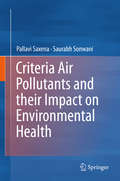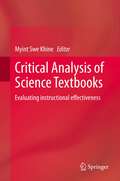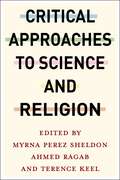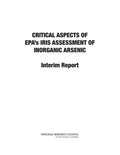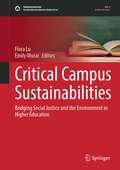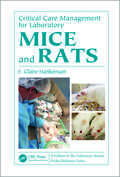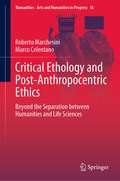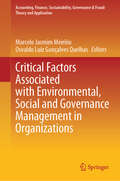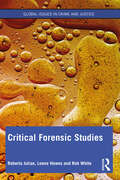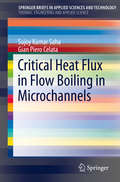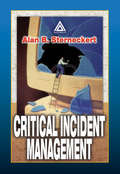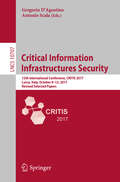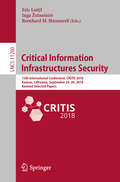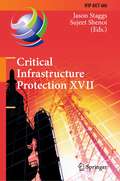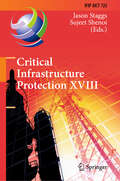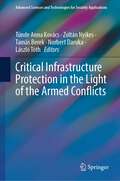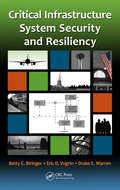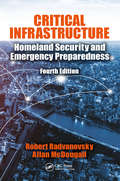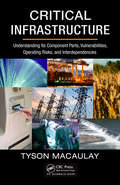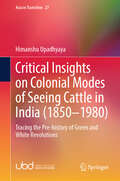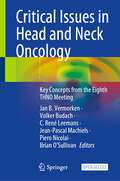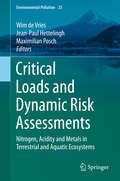- Table View
- List View
Criteria Air Pollutants and their Impact on Environmental Health
by Pallavi Saxena Saurabh SonwaniAir pollution is a global hazard. Majority of the world’s population is affected by air pollution. Contamination of air is no more an only an atmospheric problem but now has become a health concern too. Under the Clean Air Act of 1971, a set of air pollutants are designated as criteria pollutants. These are suspected to be strongly harming the public health and the environment as compared to other primary and secondary pollutants. Globally, this category of air pollutants has been given less attention, only few studies have been reported in this area. This book begins with a short background on criteria air pollutants and their sources, sinks and chemistry. The chapters explore the detailed nature of primary pollutants criteria pollutants such as nitrogen dioxide, sulphur dioxide, carbon monoxide, particulate matter and lead. Their reaction mechanisms, climate change potency, environmental health effects on plants and human life are discussed. The book also covers secondary pollutants such as ozone. The book discusses ozone chemistry and its environmental health effects. This book act as a valuable tool for students in Environmental Science, Biological Science and Agriculture, as well as environmental consultants and professionals involved in air quality research and the application of air quality guidelines and advice.
Critical Analysis of Science Textbooks: Evaluating instructional effectiveness
by Myint Swe KhineThe critical analysis of science textbooks is vital in improving teaching and learning at all levels in the subject, and this volume sets out a range of academic perspectives on how that analysis should be done. Each chapter focuses on an aspect of science textbook appraisal, with coverage of everything from theoretical and philosophical underpinnings, methodological issues, and conceptual frameworks for critical analysis, to practical techniques for evaluation. Contributions from many of the most distinguished scholars in the field give this collection its sure-footed contemporary relevance, reflecting the international standards of UNESCO as well as leading research organizations such as the American Association for the Advancement of Science (whose Project 2061 is an influential waypoint in developing protocols for textbook analysis). Thus the book shows how to gauge aspects of textbooks such as their treatment of controversial issues, graphical depictions, scientific historiography, vocabulary usage, accuracy, and readability. The content also covers broader social themes such as the portrayal of women and minorities. "Despite newer, more active pedagogies, textbooks continue to have a strong presence in classrooms and to embody students' socio-historical inheritance in science. Despite their ubiquitous presence, they have received relatively little on-going empirical study. It is imperative that we understand how textbooks influence science learning. This book presents a welcome and much needed analysis." Tina A. Grotzer Harvard University, Cambridge, Massachusetts, USA The present book provides a much needed survey of the current state of research into science textbooks, and offers a wide range of perspectives to inform the 'science' of writing better science textbooks. Keith S Taber University of Cambridge, Cambridge, United Kingdom
Critical Approaches to Science and Religion
by Sheldon, Myrna Perez; Ragab, Ahmed; Keel, TerenceCritical Approaches to Science and Religion offers a new direction for scholarship on science and religion that examines social, political, and ecological concerns long part of the field but never properly centered. The works that make up this volume are not preoccupied with traditional philosophical or theological issues. Instead, the book draws on three vital schools of thought: critical race theory, feminist and queer theory, and postcolonial theory. Featuring a diverse array of contributors, it develops critical perspectives by examining how histories of empire, slavery, colonialism, and patriarchy have shaped the many relationships between science and religion in the modern era. In so doing, this book lays the groundwork for scholars interested in speaking directly to matters such as climate change, structural racism, immigration, health care, reproductive justice, and sexual identity.
Critical Aspects of EPA's IRIS Assessment of Inorganic Arsenic
by Committee on Inorganic ArsenicThe US Environmental Protection Agency (EPA) Integrated Risk Information System (IRIS) program develops toxicologic assessments of environmental contaminants. IRIS assessments provide hazard identification and dose-response assessment information. The information is then used in conjunction with exposure information to characterize risks to public health and may be used in risk-based decisionmaking, in regulatory actions, and for other risk-management purposes. Since the middle 1990s, EPA has been in the process of updating the IRIS assessment of inorganic arsenic. In response to a congressional mandate for an independent review of the IRIS assessment of inorganic arsenic, EPA requested that the National Research Council convene a committee to conduct a two-phase study. "Critical Aspects of EPA's IRIS Assessment of Inorganic Arsenic" is the report of the first phase of that study. This report evaluates critical scientific issues in assessing cancer and noncancer effects of oral exposure to inorganic arsenic and offers recommendations on how the issues could be addressed in EPA's IRIS assessment.
Critical Campus Sustainabilities: Bridging Social Justice and the Environment in Higher Education (Sustainable Development Goals Series)
by Flora Lu Emily MuraiIn response to student demands reflecting the urgency of societal and ecological problems, universities are making a burgeoning effort to infuse environmental sustainability efforts with social justice. In this edited volume, we extend calls for higher education leaders to revamp programming, pedagogy, and research that problematically reproduce dominant techno-scientific and managerial conceptualizations of sustainability. Students, staff and community partners, especially those from historically underrepresented and marginalized groups, are at the forefront of calls for critical sustainabilities programming, education and collaborations. Their work centers themes of power relations, (in)equity, accessibility, and social (in)justice to study the interrelationships between humans, non-humans, and the environment. Their voices, perspectives and lived experiences are provocations for institutions to think and act more expansively. This book amplifies some of these voices and bottom up efforts toward a more critical approach to sustainability on campus. We ground our recommendations on findings from campus-wide surveys that were taken by over 8,000 undergraduates in 2016, 2019, and 2022. Furthermore, we share the design principles and lessons learned from several innovative, award-winning initiatives designed to foster critical sustainabilities at UC Santa Cruz.
Critical Care Management for Laboratory Mice and Rats (Laboratory Animal Pocket Reference)
by F. Claire HankensonFor critical care of laboratory rodents, there is a scarcity of sources for comprehensive, feasible, and response-oriented information on clinical interventions specific to spontaneous and induced models of disease. With the more complex cases that need critical care management, many treatment approaches to veterinary emergencies cannot be applied
Critical Dynamics
by Uwe C. TäuberIntroducing a unified framework for describing and understanding complex interacting systems common in physics, chemistry, biology, ecology, and the social sciences, this comprehensive overview of dynamic critical phenomena covers the description of systems at thermal equilibrium, quantum systems, and non-equilibrium systems. Powerful mathematical techniques for dealing with complex dynamic systems are carefully introduced, including field-theoretic tools and the perturbative dynamical renormalization group approach, rapidly building up a mathematical toolbox of relevant skills. Heuristic and qualitative arguments outlining the essential theory behind each type of system are introduced at the start of each chapter, alongside real-world numerical and experimental data, firmly linking new mathematical techniques to their practical applications. Each chapter is supported by carefully tailored problems for solution, and comprehensive suggestions for further reading, making this an excellent introduction to critical dynamics for graduate students and researchers across many disciplines within physical and life sciences.
Critical Ethology and Post-Anthropocentric Ethics: Beyond the Separation between Humanities and Life Sciences (Numanities - Arts and Humanities in Progress #16)
by Roberto Marchesini Marco CelentanoThe primary purpose of this book is to contribute to an overcoming of the traditional separation between humanties and life sciences which, according to the authors, is required today both by the developments of these disciplines and by the social problems they have to face. The volume discusses the theoretical, epistemological and ethical repercussions of the main acquisitions obtained in the last decades from the behavioral sciences. Both the authors are inspired by the concept of a “critical ethology”, oriented to archive the nature/culture and human/animal dichotomies. The book proposes a theoretical and methodological restructuring of the comparative study of the animal behavior, learning, and cultures, focused on the fact that thought, culture and language are not exclusively human prerogatives. The proposed analysis includes a critique of speciesism and determinism in the ethical field, and converge with the Numanities, to which the series is dedicated, on a key point: it is necessary to arrive at an education system able to offer scientific, social and ethical skills that are trasversal and transcendent to the traditional humanities/life sciences bipartition. Skills that are indispensable for facing the complex challenges of the contemporary society and promoting a critical reflection of humanity on itself.
Critical Factors Associated with Environmental, Social and Governance Management in Organizations (Accounting, Finance, Sustainability, Governance & Fraud: Theory and Application)
by Marcelo Jasmim Meiriño Osvaldo Luiz Gonçalves QuelhasThis book offers a comprehensive exploration of Environmental, Social, and Governance (ESG) principles, showing how they can be harnessed to enhance organizational sustainability. In an era where ESG is gaining increasing recognition for its transformative potential, this work delves into the practical aspects of leveraging ESG to improve governance, bolster corporate image, build credibility, and foster reputation. It also unveils the exciting realm of new business opportunities, particularly in the domains of social and environmental responsibility. What sets this book apart is its hands-on approach. Each chapter unfolds with compelling real-life case studies that draw readers into the dynamic world of ESG. As you progress through the pages, readers encounter thought-provoking questions and challenging case scenarios, inviting you to not just passively absorb information, but actively engage with the material. The readers are prompted to reflect on these cases, formulate questions, and even tackle proposed solutions, making readers’ learning experience highly interactive and deeply insightful. The main benefit readers will derive from this work is a panoramic understanding of ESG—from its theoretical underpinnings to its practical implementation. Beyond just providing knowledge, this book equips the reader with a toolkit of ESG management strategies that can be implemented in their own organizations.
Critical Forensic Studies (Global Issues in Crime and Justice)
by Rob White Roberta Julian Loene HowesThis book provides a comprehensive overview of the emerging interdisciplinary field of critical forensic studies. It reviews existing research and scholarship on forensic science from a critical social science perspective, while forging a blueprint for further work in this area. Forensic science has long captured the public imagination, as evidenced by the popularity of many novels, television programmes, and true-crime podcasts. At the same time, its role in the criminal justice system has been the subject of critique from scholars and practitioners in diverse fields. In response, the international forensic science community has become more involved in the scrutiny of its own knowledge and practices in relation to criminal justice objectives. Moving beyond a discussion of forensic science as a suite of specialised scientific disciplines that aim to provide evidence to the courts, Critical Forensic Studies offers critical insights relevant to a wide range of social actors in the criminal justice system. Core content includes: • the history and public understandings of forensic science• the professionalisation of forensic science• forensic science as a social process• crime scene examination and forensic intelligence• experts and evidence in court• technological advances and human rights• interdisciplinary knowledge, practice and research This book is essential reading for forensic and criminal justice practitioners and students across criminology, sociology, forensic science, law, and psychology.
Critical Heat Flux in Flow Boiling in Microchannels (SpringerBriefs in Applied Sciences and Technology)
by Sujoy Kumar Saha Gian Piero CelataThis Brief concerns the important problem of critical heat flux in flow boiling in microchannels. A companion edition in the SpringerBrief Subseries on Thermal Engineering and Applied Science to "Heat Transfer and Pressure Drop in Flow Boiling in Microchannels," by the same author team, this volume is idea for professionals, researchers, and graduate students concerned with electronic cooling.
Critical Incident Management
by Alan B. SterneckertMost businesses are aware of the danger posed by malicious network intruders and other internal and external security threats. Unfortunately, in many cases the actions they have taken to secure people, information and infrastructure from outside attacks are inefficient or incomplete. Responding to security threats and incidents requires a competent
Critical Incident Management: A Complete Response Guide, Second Edition
by Vincent Faggiano Thomas T. Gillespie John McNallTerrorism threats and increased school and workplace violence have always generated headlines, but in recent years, the response to these events has received heightened media scrutiny. Critical Incident Management: A Complete Resource Guide, Second Edition provides evidence-based, tested, and proven methodologies applicable to a host of scenarios t
Critical Information Infrastructures Security: 12th International Conference, Critis 2017, Lucca, Italy, October 8-13, 2017, Revised Selected Papers (Lecture Notes in Computer Science #10707)
by Gregorio D'Agostino Antonio ScalaThis book constitutes revised selected papers from the 12th International Conference on Critical Information Infrastructures Security, CRITIS 201, held in Lucca, Italy, in October 2017. The 21 full papers and 4 short papers presented were carefully reviewed and selected from 63 submissions. They present innovative research and explore new challenges in the field of critical information infrastructures protection (C(I)IP) and deal with multi-disciplinary approaches to relevant C(I)IP problems.
Critical Information Infrastructures Security: 13th International Conference, CRITIS 2018, Kaunas, Lithuania, September 24-26, 2018, Revised Selected Papers (Lecture Notes in Computer Science #11260)
by Eric Luiijf Inga Žutautaitė Bernhard M. HämmerliThis book constitutes revised selected papers from the 13th International Conference on Critical Information Infrastructures Security, CRITIS 2018, held in Kaunas, Lithuania, in September 2018.The 16 full papers and 3 short papers presented were carefully reviewed and selected from 61 submissions. They are grouped in the following topical sections: advanced analysis of critical energy systems, strengthening urban resilience, securing internet of things and industrial control systems, need and tool sets for industrial control system security, and advancements in governance and resilience of critical infrastructures.
Critical Infrastructure Protection XVII: 17th IFIP WG 11.10 International Conference, ICCIP 2023, Arlington, VA, USA, March 13–14, 2023, Revised Selected Papers (IFIP Advances in Information and Communication Technology #686)
by Sujeet Shenoi Jason StaggsThe information infrastructure – comprising computers, embedded devices, networks and software systems – is vital to operations in every sector: chemicals, commercial facilities, communications, critical manufacturing, dams, defense industrial base, emergency services, energy, financial services, food and agriculture, government facilities, healthcare and public health, information technology, nuclear reactors, materials and waste, transportation systems, and water and wastewater systems. Global business and industry, governments, indeed society itself, cannot function if major components of the critical information infrastructure are degraded, disabled or destroyed. Critical Infrastructure Protection XVII describes original research results and innovative applications in the interdisciplinary field of critical infrastructure protection. Also, it highlights the importance of weaving science, technology and policy in crafting sophisticated, yet practical, solutions that will help secure information, computer and network assets in the various critical infrastructure sectors. Areas of coverage include: Themes and IssuesSmart Grid Risks and ImpactsNetwork and Telecommunications Systems SecurityInfrastructure SecurityAutomobile Security This book is the seventeenth volume in the annual series produced by the International Federation for Information Processing (IFIP) Working Group 11.10 on Critical Infrastructure Protection, an international community of scientists, engineers, practitioners and policy makers dedicated to advancing research, development and implementation efforts focused on infrastructure protection. The book contains a selection of eleven edited papers from the Seventeenth Annual IFIP WG 11.10 International Conference on Critical Infrastructure Protection, which was held at SRI International, Arlington, Virginia, USA in the spring of 2023. Critical Infrastructure Protection XVII is an important resource for researchers, faculty members and graduate students, as well as for as well as for policy makers, practitioners and other individuals with interests in homeland security.
Critical Infrastructure Protection XVIII: 18th IFIP WG 11.10 International Conference, ICCIP 2024, Arlington, VA, USA, March 18–19, 2024, Proceedings (IFIP Advances in Information and Communication Technology #725)
by Sujeet Shenoi Jason StaggsThe cyber infrastructure – comprising computers, embedded devices, networks and software systems – is vital to operations in every sector: chemicals, commercial facilities, communications, critical manufacturing, dams, defense industrial base, emergency services, energy, financial services, food and agriculture, government facilities, healthcare and public health, information technology, nuclear reactors, materials and waste, transportation systems, and water and wastewater systems. Global business and industry, governments, indeed society itself, cannot function if major components of the critical infrastructure are degraded, disabled or destroyed.Critical Infrastructure Protection XVIII describes original research results and innovative applications in the interdisciplinary field of critical infrastructure protection. Also, it highlights the importance of weaving together science, technology and policy to craft sophisticated, yet practical, solutions that will help secure information, computer and network assets in the various critical infrastructure sectors. Areas of coverage include: Infrastructure Security Advanced Manufacturing Security Industrial Control System Security Infrastructure Modeling This book is the eighteenth volume in the annual series produced by the International Federation for Information Processing (IFIP) Working Group 11.10 on Critical Infrastructure Protection, an international community of scientists, engineers, practitioners and policy makers dedicated to advancing research, development and implementation efforts focused on infrastructure protection. The book contains a selection of nine edited papers from the Eighteenth Annual IFIP WG 11.10 International Conference on Critical Infrastructure Protection, which was held at SRI International, Arlington, Virginia, USA in the spring of 2024. Critical Infrastructure Protection XVIII is an important resource for researchers, faculty members and graduate students, as well as for policy makers, practitioners and other individuals with interests in homeland security.
Critical Infrastructure Protection in the Light of the Armed Conflicts (Advanced Sciences and Technologies for Security Applications)
by László Tóth Tünde Anna Kovács Zoltán Nyikes Tamás Berek Norbert DarukaThis book summarizes the latest findings in critical infrastructure protection and related research areas. Armed conflicts and wars are now closer to Europe than at any time in the last several decades, and the protection of critical infrastructures has gained new prominence. This situation has also revealed the vulnerability of critical infrastructure and the importance of its protection. The development of technologies, cybertechnologies, and digitalization in all aspects of our daily lives implies new security challenges in critical infrastructure protection and security science and this book addresses the four main dimensions of critical infrastructure protection: 1. Physical protection 2. Cybersecurity 3. Political security 4. Individual security The issue of physical security has accompanied humanity since its birth. Nowadays, this issue has become even more important due to technological advances, as this is the security area that people physically experience—physical protection, including protection against explosions and ballistic attacks, but also defense of objects and guaranteeing transportation security. Cyberspace represents the fifth domain of warfare and a central security question in our age. The base of cyberspace defense is high-quality hardware and expert support. With our lives increasingly digital, cybersecurity's core elements include safety awareness and informatics. Political security, the third dimension, is shaped by diverse political ideologies influencing economies, societies, and other aspects of life. This book explores topics such as migration policies, defense against terrorism, national and international security, and public safety.The fourth dimension, individual security, spans healthcare, food safety, energy supplies, and economic security. Each chapter of this book emphasizes security, focusing on Central Europe while addressing global concerns. Authored by researchers, experts, and scholars, this book is invaluable for Ph.D. students, professionals, and educators worldwide.The fourth dimension, individual security, spans healthcare, food safety, energy supplies, and economic security. Each chapter of this book emphasizes security, focusing on Central Europe while addressing global concerns. Authored by researchers, experts, and scholars, this book is invaluable for Ph.D. students, professionals, and educators worldwide. The fourth dimension, individual security, spans healthcare, food safety, energy supplies, and economic security. Each chapter of this book emphasizes security, focusing on Central Europe while addressing global concerns. Authored by researchers, experts, and scholars, this book is invaluable for Ph.D. students, professionals, and educators worldwide. The fourth dimension, individual security, spans healthcare, food safety, energy supplies, and economic security. Each chapter of this book emphasizes security, focusing on Central Europe while addressing global concerns. Authored by researchers, experts, and scholars, this book is invaluable for Ph.D. students, professionals, and educators worldwide. The fourth dimension, individual security, spans healthcare, food safety, energy supplies, and economic security. Each chapter of this book emphasizes security, focusing on Central Europe while addressing global concerns. Authored by researchers, experts, and scholars, this book is invaluable for Ph.D. students, professionals, and educators worldwide. The fourth dimension, individual security, spans healthcare, food safety, energy supplies, and economic security. Each chapter of this book emphasizes security, focusing on Central Europe while addressing global concerns. Authored by researchers, experts, and scholars, this book is invaluable for Ph.D. students, professionals, and educators worldwide. The fourth dimension, individual security, spans healthcare, food safety
Critical Infrastructure System Security and Resiliency
by Drake Warren Betty Biringer Eric VugrinSecurity protections for critical infrastructure nodes are intended to minimize the risks resulting from an initiating event, whether it is an intentional malevolent act or a natural hazard. With an emphasis on protecting an infrastructure's ability to perform its mission or function, Critical Infrastructure System Security and Resiliency presents
Critical Infrastructure: Homeland Security and Emergency Preparedness,
by Robert S. Radvanovsky Allan McDougallThis edition of Critical Infrastructure presents a culmination of ongoing research and real-work experience, building upon previous editions. Since the first edition of this work, the domain has seen significant evolutions in terms of operational needs, environmental challenges and threats – both emerging and evolving. This work expands upon the previous works and maintains its focus on those efforts vital to securing the safety and security of populations. The world continues to see a shift from a force-protection model to one more focused on resilience. This process has been exacerbated and challenged as societies face increased instability in weather and arguably climate, a destabilized geopolitical situation, and continuing economic instability. Various levels—ranging from international oversight to individual actions—continue to work towards new approaches and tools that can assist in meeting this challenge. This work keeps pace with the key changes that have occurred since previous editions and continues to provide insight into emerging and potential issues. Expanding from historical research, major areas of interest such as climate change, regulatory oversight, and internal capacity building are explored. This work provides a reference for those that are working to prepare themselves and their organizations for challenges likely to arise over the next decade. In keeping with the fast-changing nature of this field, Critical Infrastructure: Homeland Security and Emergency Preparedness, Fourth Edition has been completely revised and fully updated to reflect this shift in focus and to incorporate the latest developments. Presents an overview of some of the emerging challenges and conflicts between the public and private sector; Continues to build the case for organizations to adopt an intelligence-driven and adaptive approach to protecting infrastructure; Presents a unique and new perspective of re-examining baseline requirements against a range of shifting factors, taking a balanced approach between risk-based planning and consequence management; Expands upon the issue of internal and lone-wolf threats that pose additional challenges to a system that continues to focus largely on external threats; and An enhanced and improved view of interdependencies in an increasingly inter-connected and network-enabled world. Preparing for the challenges of increasingly unstable threat and operating environments will pose challenges at all levels. Those involved in ensuring that critical infrastructure protection and assurance efforts function effectively and efficiently—whether as government regulators, business operators, clients of various infrastructure sectors or those seeking to maintain an accountable system – will find insights into less-explored aspects of this challenging field.
Critical Infrastructure: Understanding Its Component Parts, Vulnerabilities, Operating Risks, and Interdependencies
by Tyson MacaulayCritical Infrastructure (CI) is fundamental to the functioning of a modern economy, and consequently, maintaining CI security is paramount. However, despite all the security technology available for threats and risks to CI, this crucial area often generates more fear than rational discussion. Apprehension unfortunately prompts many involved in CI p
Critical Insights on Colonial Modes of Seeing Cattle in India: Tracing the Pre-history of Green and White Revolutions (Asia in Transition #27)
by Himanshu UpadhyayaThis book traces the contours of the symbiotic relationship between crop cultivation and cattle rearing in India by reading against the grain of several official accounts from the late colonial period to the 1980s. It also skillfully unpacks the multiple cultural expressions that revolve around cattle in India and the wider subcontinent to show how this domestic animal has greatly impacted political discourses in South Asia from colonial times, into the postcolonial period. The author begins by demonstrating the dependence between the nomadic cattle breeder and the settled cultivator, at the nexus of land-livestock-agriculture, as indicated in the writings of Sir Albert Howard, who espoused some of the most sophisticated ideas on integration, holism, and mixed farming in an era when agricultural research was marked by increasing specialisation and compartmentalisation. The book springboards with the views of colonial experts who worked at imperial science institutions but passionately voiced dissenting opinions due to their emotional investment in the lives of Indian peasants, of whom Howard was a leading light. The book presents Howard and his contemporaries’ writings to then engage contemporary debates surrounding organic agriculture and climate change, tracing the path out of the treadmill of industrial agriculture and factory farming. In doing so, the book shows how, historically, animal rearing has been critically linked to livelihood strategies in the Indian subcontinent. At once a dispassionate reflection on the role played by cattle and water buffaloes in not just supporting farm operations in the agro-pastoral landscape, but also in contributing to millions of livelihoods in sustainable ways while fulfilling the animal protein in the Indian diet, the book presents contemporary lessons on development perspectives relating to sustainable and holistic agriculture. A rich and sweeping treatment of this aspect of environmental history in India that tackles the transformations prompted by the arrival of veterinary medicine, veterinary education and notions of scientific livestock management, the book is a rare read for historians, environmentalists, agriculturalists, development practitioners, and animal studies scholars with a particular interest in South Asia.
Critical Issues in Head and Neck Oncology: Key Concepts from the Eighth THNO Meeting
by Jan B. Vermorken Volker Budach C. René Leemans Jean-Pascal Machiels Piero Nicolai Brian O’SullivanThis is an open access book.With a wealth of exciting data emerging in this rapidly evolving field this book will review the state-of-the-art knowledge with emphasis on multidisciplinary decision and management of head and neck cancer. The book provides significant detail on a wide range of topics including: the role of new targets for treatment, immunotherapy, resistance mechanisms, standardizing molecular profiling programs, and new methods to guide therapeutic approaches. In addition different disease situations are addressed including different treatment approaches in primary disease and in recurrent and/or metastatic disease as well as new developments in pathology, surgery and reconstruction techniques, new systemic therapies in salivary gland cancer, and supportive care and follow-up.All disciplines involved in the treatment of head & neck cancer are covered with a focus on translation into daily practice. The 8th-THNO is designed for medical oncologists, head and neck surgeons, radiation oncologists, otolaryngologists, and other medical professionals involved in the treatment of patients with head and neck cancer.
Critical Loads and Dynamic Risk Assessments: Nitrogen, Acidity and Metals in Terrestrial and Aquatic Ecosystems (Environmental Pollution #25)
by Wim De Vries Jean-Paul Hettelingh Maximilian PoschThis book provides a unique overview of research methods over the past 25 years assessing critical loads and temporal effects of the deposition of air pollutants. It includes critical load methods and applications addressing acidification, eutrophication and heavy metal pollution of terrestrial and aquatic ecosystems. Applications include examples for each air pollution threat, both at local and regional scale, including Europe, Asia, Canada and the US. The book starts with background information on the effects of the deposition of sulphur, nitrogen and heavy metals and geochemical and biological indicators for risk assessments. The use of those indicators is then illustrated in the assessment of critical loads and their exceedances and in the temporal assessment of air pollution risks. It also includes the most recent developments of assessing critical loads and current and future risks of soil and water chemistry and biodiversity under climate change, with a special focus on nitrogen. The book thus provides a complete overview of the knowledge that is currently used for the scientific support of policies in the field of air pollution control to protect ecosystem services.
Critical Mental Health in Australia and Aotearoa New Zealand: Social and Historical Perspectives (The Politics of Mental Health and Illness)
by Effie Karageorgos Natalie Ann HendryThis interdisciplinary volume examines the social production of mental health and illness in Australia and Aotearoa (New Zealand). It draws together cutting-edge critical mental health scholarship from the region, to interrogate how personal, community, institutional and mediated relations, make and remake experiences of ‘mental health.’ In the wake of the widespread insertion of psy-considerations into everyday lives, here contributors demonstrate how the relations between communities, practices, professionals and institutions often replicate long-standing histories of discrimination and violence motivated by psychiatric classification, even as the psy-disciplines move into supposedly more transformational domains: digital technology, schooling, human resources, and social media, for example. The book’s chapters reflect the current diversity within academic studies of mental health and illness in Australia and Aotearoa. This includes a wide range of case studies from war trauma in the Australian military and pornography addiction, to the depathologisation of trans health and peer workers in mental health services. Critical Mental Health in Australia and Aotearoa New Zealand offers unique insights particular to the region, to students and scholars of critical psychology, history, sociology, medical humanities, and education.
